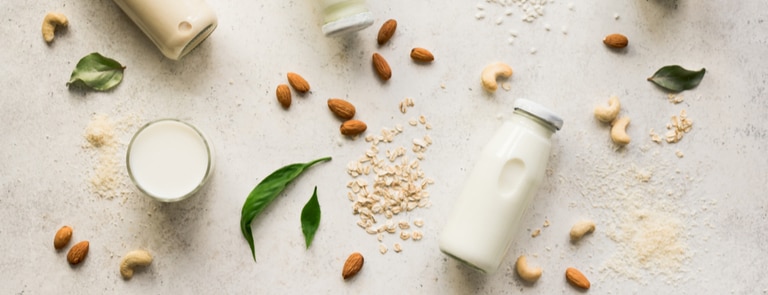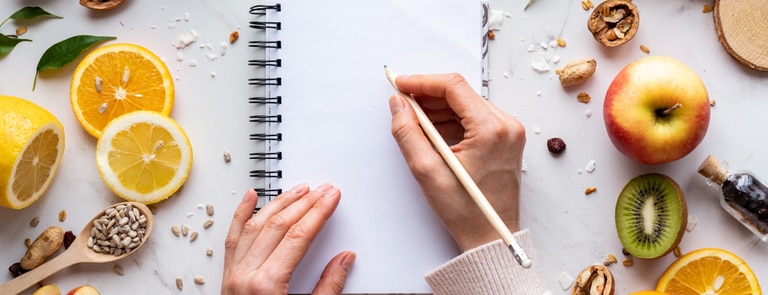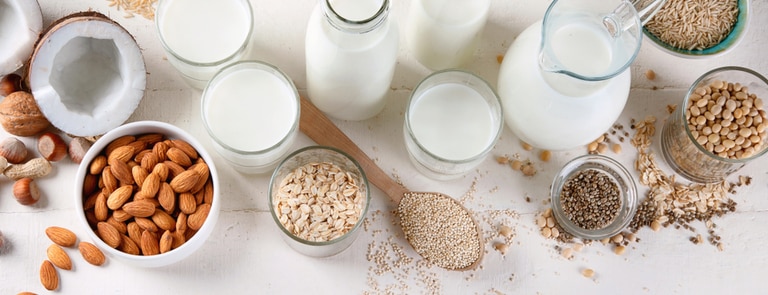20% off £30
Going dairy free: Top tips & intolerances

If the mere thought of a frothy latte makes your tummy bloat, you may be wondering what causes dairy intolerance symptoms?
Does gorging on cheese leave you suffering? Is your penchant for a cappuccino leading you to hours of discomfort?
Luckily there are shelves and menus full of dairy-free alternatives nowadays.
But before you make a rash decision to eliminate every source of dairy from your diet, it’s important to understand what’s happening to cause your reaction.
How to spot a dairy intolerance
It’s not easy.
You’ll notice from the list that follows, that these symptoms could also be signs of many other digestive conditions. For example, irritable bowel syndrome (IBS).
The difference with a dairy food intolerance is that the symptoms are directly triggered by consuming cow’s milk (and foods derived from it.)
So, the symptoms usually come on within a couple of hours of eating and last until the food eventually passes through the gastrointestinal tract.
The intensity often also varies depending on how much you consume.
Common dairy intolerance symptoms
- Stomach bloating
- Diarrhoea
- Flatulence
- Stomach cramps and pains
- Nausea
- Stomach rumbling
What is dairy intolerance?
A food intolerance describes a difficulty digesting certain foods that leads a person to experience an uncomfortable and unpleasant reaction.
In the case of dairy intolerance, milk products from cows are the culprits.
This includes some very common (and delicious) foods such as yoghurt, cheese, butter, cream and ice cream.1,2,3
So, what’s in milk-based products that causes the problem? There are two main culprits:
- Sometimes the reaction is to the protein in milk from cows (an a1 milk protein intolerance)
- But in most cases, dairy intolerance symptoms are caused by an inability to digest lactose (lactose intolerance)
In this post, we focus on lactose as the cause of dairy intolerance.
Lactose is a type of sugar mainly found in milk and dairy products. Between 1 and 2 in 10 people in the UK suffer with a lactose intolerance.4
This makes it relatively common but still raises the questions of why some people react and others don’t.
Dairy intolerance is typically caused by the body not producing sufficient lactase to digest the lactose consumed.
How does the body digest lactose?
Lactase is an enzyme produced in the small intestine.
It allows your body to break down lactose and is needed for normal digestion.
To be more specific, lactase triggers a chemical reaction that breaks lactose down into glucose and galactose. These sugars are absorbed into your bloodstream.
If there's not sufficient lactase in the small intestine, unabsorbed lactose continues to move through the gut.
Once in the large intestine, bacteria get to work breaking down the lactose.
Unfortunately, this process produces fatty acids and gases. This leads to unwanted dairy intolerance symptoms, such as flatulence, bloating and diarrhoea.
These last until the food responsible eventually passes through the gastrointestinal tract.
So essentially, it’s a lactase deficiency
Reasons for low levels of lactase in the small intestine vary. Sometimes it’s temporary.
For example, dairy intolerance can be sparked by a bout of gastroenteritis and last for a few days.
But it can also be long-lasting. For example, sometimes an inherited genetic fault causes low lactase levels.
4 causes of lactose intolerance
- Primary lactase deficiency. Lactase decreases over time reducing the ability to digest dairy.
- Secondary lactase deficiency. Damage caused by severe gastroenteritis or conditions such as coeliac disease can cause a temporary lactase shortage. Levels restore once you recover.
- Congenital lactase deficiency. Some babies are unable to produce sufficient lactase from birth, which causes difficulties with digesting dairy. This is rare.
- Developmental lactase deficiency. Some premature babies can suffer with a lactase deficiency for a short time after birth. This usually improves as they get older.4
Dairy intolerance versus food allergy
It’s important to emphasise that a dairy intolerance is not the same as an allergy.
Food intolerances are caused by sensitivities in the digestive system.
Food allergies are centred around a reaction by your immune system to a food that’s identified as an allergen. As a result, the symptoms can be very different.5
Some common dairy allergy symptoms
- Rashes and itchy skin
- Wheezing
- Tingling or itching in the mouth
- Swelling (face, mouth, throat and other areas of the body)
- Problems swallowing
- Feeling lightheaded and dizzy
- Nausea or vomiting
- Stomach pain and diarrhoea
In addition, severe food allergies can lead to anaphylaxis.
This causes breathing difficulties, difficulty swallowing, a tight chest and fainting. Anaphylaxis comes on suddenly, deteriorates quickly and can be life-threatening.
This makes food allergies serious medical conditions.
How do I know if I have a lactose intolerance?
Bloating, diarrhoea, flatulence and stomach pain. If you have any of these symptoms after eating, it’s definitely not a full done conclusion that you have a dairy intolerance.
There are a number of reasons why you could be suffering from these symptoms.
If you suspect it’s a reaction to lactose, one of the most reliable ways you can reach a diagnosis is by keeping a food diary. You can take this information to your GP.
How to keep a food diary

1
Write down everything you eat daily
Include the time you ate it, and the severity and time of any symptoms on that day.
2
Look out for patterns
Is there a pattern where eating a certain food seems to regularly coincide with a rise in your symptoms? If so, consider eliminating this from your diet for a few weeks.
3
Gradually reintroduce dairy foods in small quantities
This allows your body to adjust and accept foods it may be more sensitive to. Record any changes in your symptoms. This will identify how much you can eat without triggering a reaction.
4
Repeat with other dairy foods
If necessary, repeat these same steps with other dairy foods you may be intolerant to.
5
Consult your doctor/dietician
If after keeping a food diary and trialling elimination, you're confident you are intolerant to dairy, consult your doctor or a dietitian to confirm this.
What can I do to reduce dairy intolerance symptoms?
Unfortunately, there isn’t a cure.
But in most cases, it’s possible to manage symptoms of dairy intolerance by cutting down on dairy or avoiding food and beverages containing lactose.
How strict you need to be, and the exact diet changes required depend on how sensitive you are to lactose.
Some people may still be able to tolerate a small serving of milk on cereal without suffering any symptoms.
Others may not even be able to have a splash of milk in their cup of tea.
4 cappuccinos a day may push you over the edge, but a mug or two every week may be just fine.
It’s also possible that you react severely after consuming products containing cow’s milk, but you suffer less or not at all from goat’s milk.
Alternatively, you may find you only react to one specific type of dairy.
Every intolerance is individual. Understanding your sensitivity is crucial to managing your symptoms.
This is where the evidence gathered through a food diary can be particularly helpful.
Going dairy-free
Whether you’re cutting down on dairy or going dairy-free, you’ll need to be aware of all the foods in which lactose can be hidden.
In addition to the obviously dairy-based products in your fridge, dairy is also used as an additive in packaged foods.
These foods may not look like they contain milk, cheese or butter, but looking at the ingredients panel reveals a different reality.
Learning where dairy hides, is an important part of managing dairy intolerance symptoms.
Dairy foods to look out for:6
- Milk (from animals)
- Yoghurt
- Cream
- Cheese
- Butter and ghee
- Ice-cream
- Buttermilk
- Fromage frais
Non-dairy foods containing lactose
- Chocolate
- Salad dressings and mayonnaise
- Some ready meals
- Biscuits
- Batter e.g. around fish fingers
- Cakes
- Margarine, low fat spreads and vegetable spreads
- Certain breakfast cereals
- Cheese flavoured crisps
- Types of bread and pastries
- Some processed meats, such as sliced ham
- Look out for lactic acid (sometimes shown on product labels as E270)
11 of the best milk alternatives
There are great vegan milk products out there, but some work better for certain types of food and drink. Here are the perfect alternatives.


Lactose-free or dairy-free?
Have you seen the terms lactose-free and dairy-free on food products? Let’s clear up the confusion.
Most importantly, they don’t mean the same thing.
Dairy-free means the product is made from nuts and plants and there’s no dairy content at all.
This is very important for those with a dairy allergy and for those following a vegan diet.
Lactose-free foods are dairy products where lactase is added to aid digestion.
For example, a lactose-free dairy drink is made from cow’s milk. Adding an enzyme called lactase, helps digest any lactose so the products don’t cause any intolerance symptoms.
Otherwise it contains the same vitamins, minerals and nutrients as standard cow's milk products.
In short, lactose-free products are made for people with lactose intolerance. They aren’t suitable for vegans or people with a dairy allergy.
What about goat, buffalo and sheep milk?
Other animal milks (and products made from them) are now widely available.
Some people with lactose intolerance can consume small quantities of goat, sheep or buffalo milk, cheese, yoghurts etc, without symptoms.
This is down to these alternative milk sources containing less lactose.
Cutting out dairy from your diet
The initial difficulty for most people when giving up dairy is finding an alternative to replace everyday dairy products.
Cow’s milk is a staple in our diets.
We add it to tea, pour it on our cereals, and it’s in countless foods in our fridge and freezer.
So how do you replace it? Here are a few hints to help you to fill the dairy gap.
How to read labels
Lots of baked goods, processed food and ready-meals contain milk so you’ll need to carefully check packaging on items such as cakes, pies, soups, sauces, breakfast cereals, crisps and even processed meat and pizza, too.
The less obvious ingredients that mean dairy could be present in your food include:
- casein (or caseinates)
- rennet
- curds or whey
- lactalbumin
- milk sugar
- lactoglobulin
- lactose
- galactose
- hydrolysates
- lactalbumin phosphate
- lactate solids
- lactyc yeast
- lactitol monohydrate
- lactulose
For those new to dealing with allergies and intolerances, reading labels might seem like a daunting prospect.
Fortunately labelling regulations, which were introduced near the end of 2014, have taken the pain out of this process and allowed customers to make informed choices more easily.
Under these labelling regulations, if a product contains milk or milk derived ingredients this is now clearly indicated in the ingredients listing, typically by stating the ingredient in bold or highlighting the ingredient in a different colour.
Companies will make it clear which particular method they are using for the labelling of their product with an advisory statement, such as “for allergens see ingredients in bold”.
To make it plain that an ingredient is milk-derived, the ingredient will also have “milk” stated in brackets immediately afterwards.
For example, in the case of the milk-derived ingredient lactose, for a company where the ingredients listing lists allergens in bold, lactose would be stated as “lactose (milk)” in the ingredients listing.
This same labelling system applies to any milk-derived ingredient.
Look out for foods marked ‘suitable for vegans’
Luckily, the unstoppable trend for veganism has definitely made things easier for anyone going dairy-free.
Finding plant-based alternatives to dairy is surprisingly straightforward thanks to the hipster-approval for adopting a vegan diet.
The ‘suitable for vegans’ logo on food packaging or a menu guarantees that what you’re eating will not contain a trace of dairy.
Nut and plant-based milks
There are a wide variety of plant and nut milks available. Which one you choose depends on your taste preferences and how you’re using them.
For example, oat milk is perfect for hot beverages whereas cashew cream is great for adding to cooking. Here are a few examples:7
-
Almond milk
The light texture and sweet, nutty flavour of almond milk makes it a versatile non-dairy substitute.
Add it to coffee and tea, use it in baking and it mixes well into smoothies.
-
Soy milk
Made from soaking and grinding soy beans, soy milk has a mild and creamy flavour.
The taste can vary between brands (depending on how they process it and what sweeteners are added.)
It’s a good substitute for cow’s milk in hot drinks, on cereal and in savoury dishes.8
-
Hemp milk
Made from the seeds of the hemp plant, this milk is sweet and nutty.
It’s a good substitute for lighter milks (e.g. skimmed milk) due to its watery texture and could work well in smoothies and sauces.
-
Coconut milk
A creamy texture and subtle coconutty flavour makes coconut milk an excellent cooking ingredient. You can also add it to your hot drinks and cereals.
-
Rice milk
A mild taste, naturally sweet flavour and watery texture makes rice milk suitable to drink on its own, as well as in smoothies.
It also works well with oatmeal and in desserts.
-
Cashew cream
Rich and creamy, with a sweet and subtle nutty flavour, cashew cream is great for thickening smoothies, sauces and as a substitute for cow’s milk in desserts.
Non-dairy products (such as yoghurts and cheese)
As with non-dairy substitutes for cow’s milk, there are substitutes for other dairy products too.
These are usually produced from nuts, seeds, coconut and soy.
For example, dairy-free yoghurts are made by adding live, probiotic bacteria to nut and plant-based milks.
You can also find nut and soy-based alternatives to cheese, and plant-based butter substitutes made from vegetable oils and coconut.9
But what about dairy-free chocolate?
Milk chocolate is not dairy-free.
And it’s not just milk – other dairy-derived ingredients are often lurking in your favourite bar or snack.10
But before you resign yourself to life without your favourite sweet treat, there may be salvation sitting on the shelves of your local food store in these three options.
-
Good quality dark chocolate
The pure, untouched cocoa bean that’s the base of chocolate is naturally free of all milk ingredients.
The issue comes from what manufacturers add to chocolate.
Some good quality dark chocolates (usually the ones with the higher percentages of cocoa) are dairy-free alternatives.
But check the labels carefully as sometimes dairy-derived ingredients are used as fillers. Look out for whey, casein, and anything with the word milk.
-
Non-dairy chocolate
If dark chocolate is too bitter for your taste buds, there are some great vegan chocolate brands that make sweeter alternatives.
For example, it’s popular to add soymilk powder, coconut milk powder, cashews, hemp seeds, or oat flour to get closer to the milk and white chocolate tastes.
-
Carob
If you’re lactose-intolerant, carob is a great sweet treat alternative to chocolate.
It tastes like chocolate, but unlike cocoa powder, it’s naturally sweet.
Handpicked content: 12 best vegan chocolates - including customer reviews
But is there anything you’ll be missing out on?
Of course, eliminating a food group is not just about missing out on the taste of chocolate and the texture of your favourite hard cheese.
There are important nutritional considerations too.
Cutting out dairy may reduce your dairy intolerance symptoms, but it also means you could be missing out on other vital nutrients contained in cow’s milk and products derived from it.11
For example, most dairy products are rich in calcium. Calcium is important for bone health, regulating muscle contractions and ensuring your blood clots normally.
So, if you’re cutting out dairy, it’s important you get your daily calcium intake from other sources.
Green leafy vegetables, soya beans, tofu, nuts, bread and fish containing edible bones are all alternatives.
But it’s not just calcium you get from eating dairy. It’s also common for us to get a good supply of protein, vitamin D and iodine from these foods.
So, making sure you’re finding alternative sources for these nutrients is also important.
Handpicked content: 8 essential nutrients for vegans
Summary: Cut down on lactose to reduce your dairy intolerance symptoms
If you’re worried you may be lactose intolerant, the first thing to do is speak to your doctor. Implementing a restrictive diet, such as going dairy-free, has wider implications for your nutrition and this needs to be considered.
It could also be worth speaking to a dietitian.
And if you find out you’re dairy intolerant, don’t panic. There are more options than you may think.
First of all, if you don’t want to cut out dairy entirely, it’s important to understand the level of your sensitivity.
This is where keeping a food diary is useful. You may find that you can tolerate small quantities of dairy, as long as they’re crowded out by dairy-free alternatives.
And finally, if you decide to adopt a totally non-dairy diet, there are lots of great options. The rise of veganism has definitely helped.
There are now lots of nut and plant-based alternatives to milk and dairy-derived products. It could end up being the beginning of a fabulous new food adventure.
Last updated: 1 September 2021
- https://www.nhs.uk/conditions/food-intolerance/
- https://www.nhs.uk/conditions/lactose-intolerance/
- https://www.avogel.co.uk/health/digestive-system/food-intolerance/lactose-and-dairy-intolerance/
- https://www.bupa.co.uk/health-information/nutrition-diet/lactose-intolerance
- https://www.nhs.uk/conditions/food-allergy/
- https://www.bbcgoodfood.com/howto/guide/spotlight-dairy-free
- https://www.bbcgoodfood.com/howto/guide/which-milk-right-you
- https://www.bbcgoodfood.com/howto/guide/soy-milk-good-you
- https://www.thespruceeats.com/is-chocolate-dairy-free-1000938
- https://www.nhs.uk/conditions/lactose-intolerance/
- https://www.vegan.com/dairy-free/















